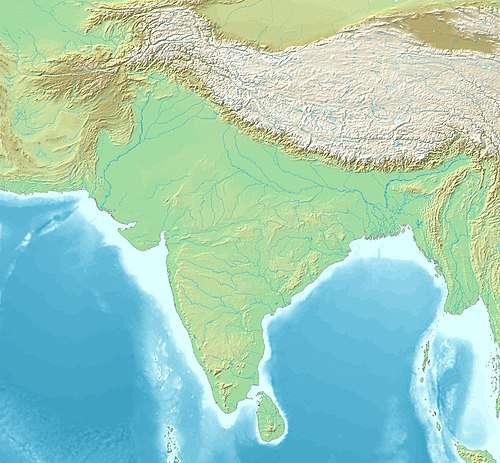Palkigundu and Gavimath, Koppal
Palkigundu (15.344167°N 76.136944°E) and Gavimath (15.3372926°N 76.1621377°E) near Koppal in Karnataka are two locations where inscriptions of Emperor Ashoka (304–232 BCE) were found. These inscriptions represent some of India's oldest written records, and are part of Ashoka's Minor Rock Edicts. Jain monks used to meditate there. The Palkigundu and Gavimath edicts are in Prakrit, written in Brahmi script. A Kannada translation of the inscriptions is available.



At Palkigundu (palanquin rock), two huge boulders are topped with a flat-shaped rock forming a canopy. Rough steps lead to the top of the boulders, where a 2,300-year-old inscription is located. Similar edicts have been found in 17 places in India.
About 2.5 km to the southeast of Palkigundu, at Gavimath, there is another rock inscription, also an edict from Ashoka.[1] The Gavimath inscription is situated on a boulder in a sheltered place with a rock canopy. Jain monks used both Gavimath and Palkigundu as locations to meditate.
Ashoka Edicts at Palkigundu
The rock edicts written in Brahmi script, talk about Ashoka becoming closer to the Sangha and becoming more ardent. Further it says any person, small or big, can achieve something if they put the effort.[2]
References
- "Message on a rock - Palkigundu and Gavimath near Koppal". Retrieved 6 June 2013.
- Iyer, Meera (5 November 2013). "A dolmen, a shop and a Jina" (Bangalore). Deccan Herald. Retrieved 21 January 2015.
| Edicts of Ashoka (Ruled 269–232 BCE) | |||||
| Regnal years of Ashoka |
Type of Edict (and location of the inscriptions) |
Geographical location | |||
| Year 8 | End of the Kalinga war and conversion to the "Dharma" |  Udegolam Nittur Brahmagiri Jatinga Rajula Mandagiri Yerragudi Sasaram Barabar Kandahar (Greek and Aramaic) Kandahar Khalsi Ai Khanoum (Greek city) | |||
| Year 10[1] | Minor Rock Edicts | Related events: Visit to the Bodhi tree in Bodh Gaya Construction of the Mahabodhi Temple and Diamond throne in Bodh Gaya Predication throughout India. Dissenssions in the Sangha Third Buddhist Council In Indian language: Sohgaura inscription Erection of the Pillars of Ashoka | |||
| Kandahar Bilingual Rock Inscription (in Greek and Aramaic, Kandahar) | |||||
| Minor Rock Edicts in Aramaic: Laghman Inscription, Taxila inscription | |||||
| Year 11 and later | Minor Rock Edicts (n°1, n°2 and n°3) (Panguraria, Maski, Palkigundu and Gavimath, Bahapur/Srinivaspuri, Bairat, Ahraura, Gujarra, Sasaram, Rajula Mandagiri, Yerragudi, Udegolam, Nittur, Brahmagiri, Siddapur, Jatinga-Rameshwara) | ||||
| Year 12 and later[1] | Barabar Caves inscriptions | Major Rock Edicts | |||
| Minor Pillar Edicts | Major Rock Edicts in Greek: Edicts n°12-13 (Kandahar) Major Rock Edicts in Indian language: Edicts No.1 ~ No.14 (in Kharoshthi script: Shahbazgarhi, Mansehra Edicts (in Brahmi script: Kalsi, Girnar, Sopara, Sannati, Yerragudi, Delhi Edicts) Major Rock Edicts 1-10, 14, Separate Edicts 1&2: (Dhauli, Jaugada) | ||||
| Schism Edict, Queen's Edict (Sarnath Sanchi Allahabad) Lumbini inscription, Nigali Sagar inscription | |||||
| Year 26, 27 and later[1] |
Major Pillar Edicts | ||||
| In Indian language: Major Pillar Edicts No.1 ~ No.7 (Allahabad pillar Delhi pillar Topra Kalan Rampurva Lauria Nandangarh Lauriya-Araraj Amaravati) Derived inscriptions in Aramaic, on rock: | |||||